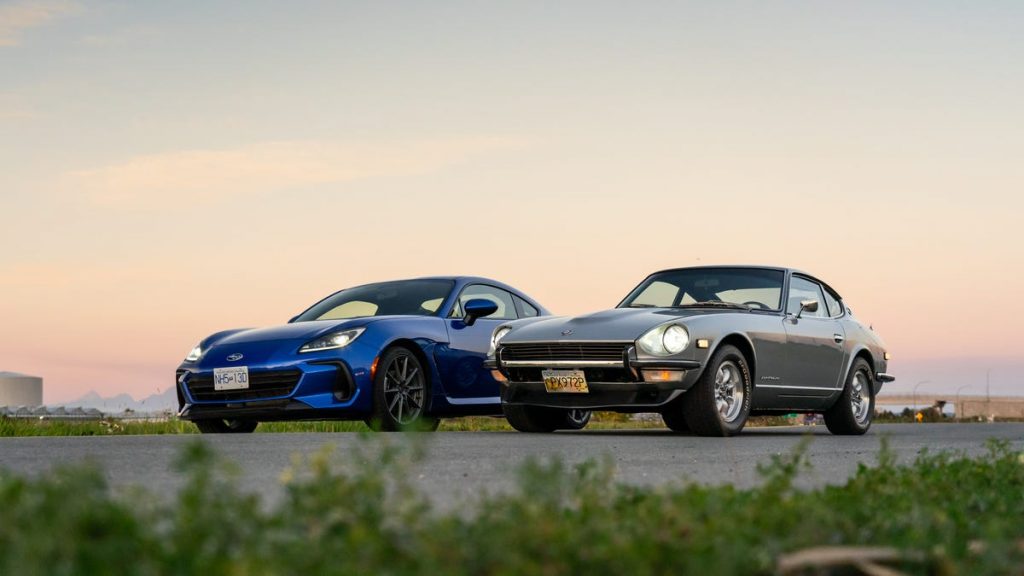The Subaru BRZ Is the True Modern-Day Datsun 240Z

Photo: Brendan McAleer
Photographers call the time just before sunset the “golden hour.” The light’s like honey, filtered by a thick wedge of atmosphere, burnishing everything with its glow. But even in the flatlands near Tsawwassen, British Columbia, with mountains far away on the horizon, nature will shortchange you. Today, this rapidly closing window will last just 40 minutes.
For a short moment, the long-wavelength end of the visible light spectrum paints the flanks of two mechanical soul mates. Well, arguably soul mates. One old, one new. One ground-breaking icon, one budget-minded refresh. One a symbol of an entire company’s sporting identity; the other at odds with everything else that wears the same badge.
Photo: Brendan McAleer
Naturally, comparing the BRZ and the 240Z in a (literal) favorable light will have a few purists cocking their slings and arrows. But please don’t lob a rock at my head, because it’s not just me. In fact, I share this opinion with none other than the father of the Z himself, Yutaka Katayama.
In 2010, when he was 100 years old, the UK-based magazine Autocar took “Mr. K.” out for a spin around Yokohama in a 370Z convertible. Japan-based editor Peter Nunn summed up the great man’s thoughts: “To Mr K., the Z-car should be simpler — styled like a thoroughbred, but with a price accessible to young people. It should offer the same kind of character and involvement that you can get from a Mazda MX-5, or even a Caterham.”
G/O Media may get a commission
20% off
Ettitude – 20% Off
20% off bundled bamboo bedding
The brand’s proprietary CleanBamboo is a soft, breathable fabric; their signature sateen is cool to the touch.
To Katayama, the 370Z was already too big, heavy, and complex. Mr. K died in 2015, age 105, but I think we can safely extrapolate that he would have felt much the same about the new Z, with its twin-turbo engine and 3500-lb curb weight.
Photo: Brendan McAleer
Which is not to throw the new Z under the bus, because it’s a thoroughly satisfying machine — merely one with a different mission than the original 240Z. The owner of this 1972 example, Ray Carroll, is front-row in the target audience for the new Z, and has in fact done nearly everything in his power to try to get a Z Proto allocation. He owned another Z in his youth, daily-drives his classic outside of the winter months, and is fired up about a new car that captures some of that essence of Z nostalgia.
But then again, he can afford it. The new Z is a relative bargain compared to a Supra or even a 718 Cayman, but a properly optioned Z lists at ten bucks short of 50 grand. The original 240Z cost roughly $3500 when new. Adjusted for inflation, that’s roughly $27,000 in today’s money.
MSRP on the BRZ? $28,595.
Photo: Brendan McAleer
Because the 240Z is such a pretty machine, and was such a game-changer for the Japanese car industry, we sometimes overlook that the appeal of the car was that it was cheap. Maybe not college-kid cheap, but certainly affordable enough if you had any kind of decent job. A gorgeous two-doored reward for keeping your nose to the grindstone.
Likewise, the Subaru is within reach of the less well-heeled heel-and-toe crowd. This thing is GTI money, not Golf R money. WRX money, not STI money. Oh right, Subaru doesn’t do an STI any more. There now, I’ve gone and made myself sad.
Not too sad, however, because this is actually my BRZ. My non-F40 dream car was an ND2 MX-5 Miata I could share with my kids. Subaru’s response appears to have been, “would you like it in blue?”
Photo: Brendan McAleer
After roughly 5,000 miles of ownership, I’m happy to report that the BRZ is a really great car despite not being an actual Great Car. It is sized just right for blasting through curving roads of coastal mountains. It is just big enough to fit my grade-school-aged kids for a 1,500-mile loop to the dinosaur museum in Alberta’s badlands. I took it to Dirtfish rally school, discovering that, in the dirt, rear-drive Subarus are even more fun than all-wheel-drive ones.
On the deck of one of the cable ferries of the Kootenay lakes, otherwise packed with crossovers and RVs, a young kid offered up a yell, “Cool car.” Dropping off Kid 2 for swimming, an older gent buttonholed me about what it was like. “I need a new daily,” he said, “I’ve got an MR2 Turbo and a 240Z at home.” The BRZ is not a volume car, but it gets some golf claps.
Photo: Brendan McAleer
As is common when you drive a particular car, I began to notice more of the previous-generation Toyobarus around. Some stock, some modified with Instagram handles on the back windows. Mostly younger drivers, perhaps second owners.
When I say the BRZ is not a capital-G, capital-C Great Car, I don’t mean to undersell its cultural impact. In many ways, it’s probably the 240SX of our times: accessible rear-drive performance for the small segment of the population that wants it. It never sold in huge numbers, but there are enough of the first-gen cars sloshing around in the market to fulfill the drifty dreams of younger buyers.
Photo: Brendan McAleer
The incremental improvements to the second-gen BRZ and GT86 make it a much more satisfying car to own. The added torque from the larger engine means you can climb into the powerband more quickly. And that 2.4-liter displacement now neatly matches the L-series engine under the long hood of this 1972 240Z. At least in volume, though it can’t touch the old car for character.
Sitting behind the wheel of Carroll’s silver ‘72 240Z, I can’t imagine the impact this car had when new. Imagine trading in some hand-me-down Plymouth on this sports car. This fracturing of established car culture is what made the original Z a Great Car. I once had the opportunity to drive one of the earliest Fairladys, a Datsun SPL213, and it showed me why the average 1960s North American consumer might have dismissed Japanese cars as disposable and toy-like. The 240Z rolled up and changed everything.
Photo: Brendan McAleer
Regrettably, my argument for the BRZ falls apart more than a bit when the Datsun’s 2.4-liter inline six lights off. Subaru can tout the low center of gravity of its flat-four engines all it wants, but you just can’t compare the audible experience of an old carbureted engine to that of a modern car. The former is like being at a live concert; the latter is like walking past a room with a quiet radio playing that same tune.
Again, Carroll’s Z is a daily, not a collector, so he’s massaged it a little. The throttle response is immediate, and the L-series positively snarls as the revs climb. Old-car expectations include great forward visibility with narrow A-pillars, but the lack of slack in the steering is a refreshing surprise for a car that’s hit the half-century mark.
Add in the smell of oil and combustion in the light of a dying day, and you’ve got an experience that’s hard to remaster. The Subaru just smells like plastic and, well, whatever small dashboard rattles smell like.
Photo: Brendan McAleer
And yet, the similarities outweigh the differences. Carroll gives the BRZ a go, and at 6’4”, he fits just fine. He remarks that the visibility’s pretty good, especially by modern standards, and he doesn’t mind the piped-in engine noise — though right away, he clocks that it’s fake.
He’s still after a new Z. What Nissan has created is a sort of greatest-hits Z package, with a twin-turbo dollop of 300ZX heritage that’s hard to deny. Frankly, we’re lucky to have a Z at all; Nissan could have spent that money on an infotainment upgrade for the Rogue. That Nissan was able to build a sports car that offers more engagement than the Toyota Supra — if, perhaps, not quite the same level of pace — is to be applauded.
Photo: Brendan McAleer
The BRZ and the GT86, though, are closer to what the original 240Z represented. Light enough to make Mr. K. grin. Not a V8 Mustang, but well worth a visit to the clockwise end of the tachometer. Within financial reach, and not a back-breaker to keep in fuel and tires. The kind of car that you bake a couple of good stories into.
Then, sprinting back to a promising photo spot, we suddenly lose the light. The warm golden glow is everywhere at once, then out like a light switch. A cool blue twilight emphasizes the shadows on the two cars, and a crescent moon gently clears its voice in the sky above.
Photo: Brendan McAleer
It’s been an unseasonably warm and dry fall here, but the end of the year is coming. When the rain and clouds arrive, they’ll bring wet-newspaper skies and short, dark days. Any golden hours will be few and far between.
On the drive home, I’m thinking of bookends, or perhaps the closing of a chapter. Not in a gloomy way, but merely as one of the divisions by which we order time. An idea has a genesis. Sometimes it has an end. The golden time doesn’t seem to last long enough. But tomorrow’s dawn will bring something new. They call the brief time after sunrise a golden hour, too.



